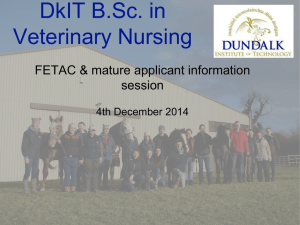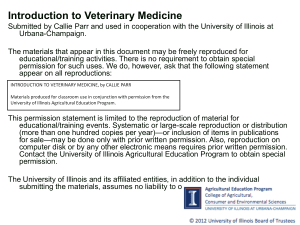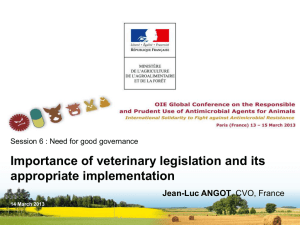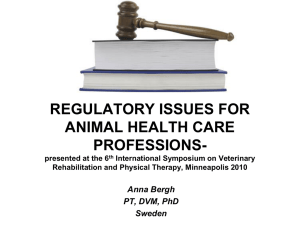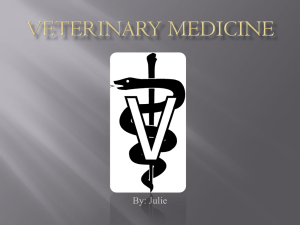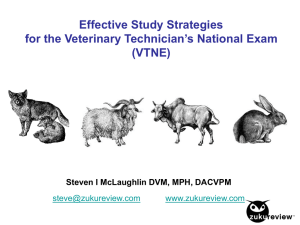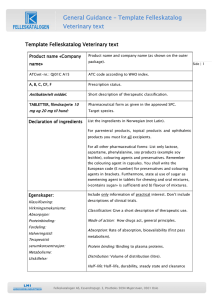History of Veterinary Medicine
advertisement
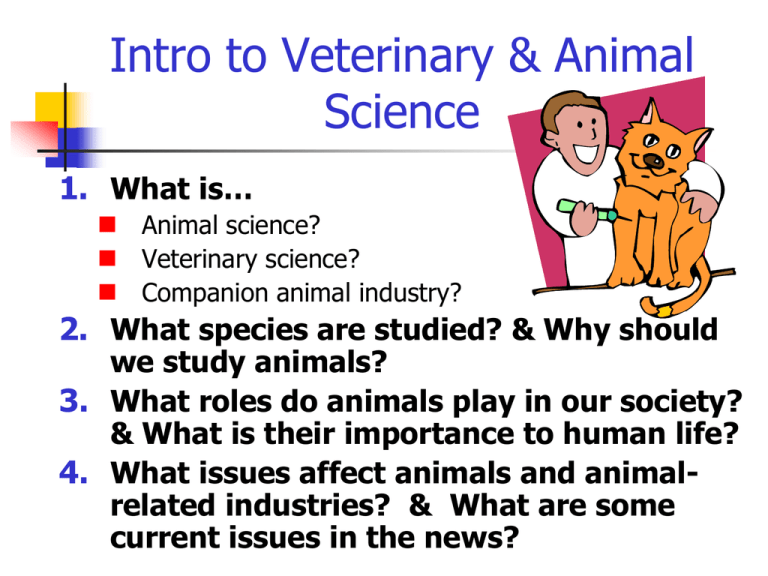
Intro to Veterinary & Animal Science 1. What is… Animal science? Veterinary science? Companion animal industry? 2. What species are studied? & Why should we study animals? 3. What roles do animals play in our society? & What is their importance to human life? 4. What issues affect animals and animalrelated industries? & What are some current issues in the news? Directions: Create this 3 column grid in your notes. Read the following terms and come up with your OWN definition for each term. (Think about each word in the term to create your definition). We will come together and come up with our class definition once everyone has finished their terms. Term 1. Animal industry 2. Animal marketing 3. Animal processing 4. Animal production 5. Domestication 6. Animal supplies 7. Veterinary medicine 8. Zoology Your Definition All of the activities in raising animals and meeting the needs of people for animal products. Name _____________________________ Period ______ Date __________________ Class Definition What is Animal Science? The knowledge of the growth, care, management and production of domestic animals based on scientific research. When did it begin? Evidence indicates that the dog has been man’s best friend for over 12,000 years! Domestication of sheep, swine, horses, cattle poultry and rabbits soon followed. Domestication Not just tame… kept for a distinct purpose develop traits that are not found in the wild humans control their breeding survival depends on humans Benefits to humans: Allowed humans to contain animals with the right temperament. Selective breeding occurred, as humans got rid of animals with undesirable traits, not allowing them to reproduce. Ensured a steady food supply. Animals were used for companionship, religious purposes and work. In return, they received protection and a constant food supply. Veterinary Medicine History Notes: Year and Event How it affects our history Directions: 1. Fold your notebook paper in half 2. Title the top of each column 3. Left Column: Write the date and event 4. Right Column: directly across from the date; write how that event changed history and the veterinary field. The History of Veterinary Medicine 9000 BC - Basic medical skills existed among Middle Eastern shepherding cultures. 1850 BC - Egyptian medical textbook shows that ancient Egyptians understood veterinary anatomy, recognized symptoms of certain diseases, and practiced specific forms of treatment. 1766 BC – Traditional Chinese medicine is practiced on humans and animals. 300 BC – Nei Ching Su Wen is the first Chinese medical text detailing anatomy, physiology and other medical knowledge. 200 BC-1700’s AD – Books on vet medicine have been found from the Chinese, Hindus, Babylonians, Hebrews, Arabs, Greeks, Romans and French. History of Veterinary Education The first veterinary school was founded in Lyons, France in 1761. Later known as the Royal Veterinary School, its purpose was to provide study in the anatomy and diseases of horses, cattle and sheep. The first American veterinary institution, the Veterinary College of Philadelphia, operated from 1852 to 1866. The School of Veterinary Medicine at the University of Pennsylvania, established in 1883, is the oldest accredited veterinary school still operating in America. More Vet History 1600’s First transfusions performed between two dogs then between sheep and man Books describe stitches and removing dead or “proud” flesh 1700’s comprehensive textbooks cover horse, cattle, sheep, pigs and dogs 1761 – First vet school founded in Lyons, France More Vet History 1800’s studies of heart disease and heart attacks invention of the stethoscope, hypodermic syringe and needle ether is used for anesthesia, morphine is used for anaesthetic 1852 – America’s first vet school opens – the Veterinary College of Philadelphia (operated from 1852 to 1866) 1883 – The school of Veterinary Medicine at the University of Pennsylvania opens Changes coming in vet medicine 1890’s – most “horse doctors” & self-proclaimed vets still had no formal training “Patent medicines” claimed to cure everything from pinkeye to cancer. Few had any benefit & many were dangerous containing arsenic, opium, alcohol or morphine. Vets in the 20th Century 1900 – only 39% of the population lived or worked on farms 1902 – existence and function of hormones discovered 1903 – discovered that a virus causes hog cholera (a very contagious, often fatal disease) and found that recovering hogs are immune for life 1906 – Pure Food & Drug Act and the Meat Inspection Act passed making food safer, giving vets jobs, provided funding for research 1910 – Elinor McGrath & Florence Kimball were the first women vet school grads and the first pet-only vets History - more 1900’s 1914 – WWI over 50,000 service dogs were used by the British, Belgians and French which needed vet care 1920’s – Serious decline in economy & the use of horses reduces need for vets – began treating more pets. 1928 – Antibacterial properties of penicillin discovered by Sir Alexander Fleming 1930 – 81% of vets treated pets 1935 – Vet Dr. Otto Stader invented the splint to immobilize broken bones 1938 – First artificial breeding cooperative organized for dairy cattle Moving towards the 21st Century Numerous diseases discovered, diagnosed, and some are eradicated Many drugs, vaccines and medicines discovered to treat humans & animals – by the 1950’s vets could successfully treat most wounds and infections Numerous pesticides are developed New technology - invention of electron microscope & computers. Research and discoveries in biotechnology, genetics, and cloning. Numerous laws and legislations passed to protect animals, food supply & the environment 1986 – 45% of vets treat at least some large animals 2004 – only 22% of vets see any large animals

